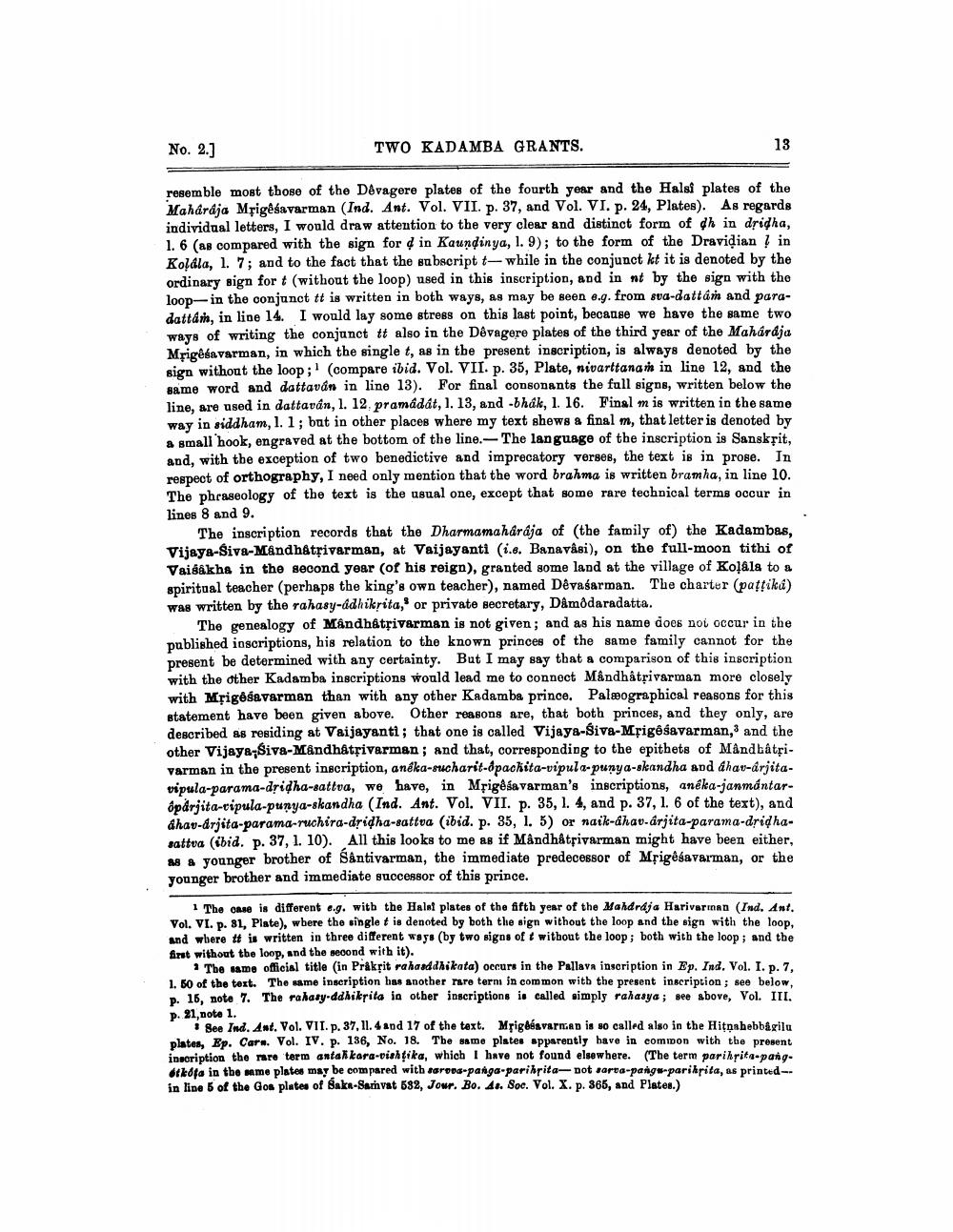________________
No. 2.]
TWO KADAMBA GRANTS.
resemble most those of the Devagere plates of the fourth year and the Halsi plates of the Maharaja Mpigêsavarman (Ind. Ant. Vol. VII. p. 37, and Vol. VI. p. 24, Plates). As regards individual letters, I would draw attention to the very clear and distinct form of dh in dridha, 1. 6 (as compared with the sign for 4 in Kaundinya, 1. 9); to the form of the Dravidian ! in Koldla, 1. 7; and to the fact that the subscript t- while in the conjunct kt it is denoted by the ordinary sign for t (without the loop) used in this inscription, and in nt by the sign with the loop- in the conjunct tt is written in both ways, as may be seen e.g. from sva-dattám and paradattan, in line 14. I would lay some stress on this last point, because we have the same two ways of writing the conjunct tt also in the Dêvagere plates of the third year of the Mahardja Mrigesavarman, in which the single t, as in the present inscription, is always denoted by the sign without the loop;' (compare ibid. Vol. VII. p. 35, Plate, nivarttanah in line 12, and the same word and dattavan in line 13). For final consonants the full signs, written below the line, are used in dattavan, 1. 12, pramådát, 1. 13, and -bhak, 1. 16. Final m is written in the same way in siddham, 1. 1; but in other places where my text shews & final m, that letter is denoted by a small hook, engraved at the bottom of the line.-The language of the inscription is Sanskrit, and, with the exception of two benedictive and imprecatory verses, the text is in prose. In respect of orthography, I need only mention that the word brahma is written bramha, in line 10. The phraseology of the text is the usual one, except that some rare technical terms occur in lines 8 and 9.
The inscription records that the Dharmamaharaja of the family of) the Kadambas, Vijaya-Siva-Måndhátrivarman, at Vaijayanti (i.6. Banavasi), on the full-moon tithi of Vaisakhs in the second year (of his reign), granted some land at the village of Koļala to a spiritual teacher (perhaps the king's own teacher), named Dêvasarman. The charter (pattika) was written by the rahasy-adhikrita, or private secretary, Damodaradatta.
The genealogy of Mandh&trivarman is not given; and as his name does not occur in the published inscriptions, his relation to the known princes of the same family cannot for the present be determined with any certainty. But I may say that a comparison of this inscription with the other Kadamba inscriptions would lead me to connect Måndhâtpivarman more closely with Mrigésavarman than with any other Kadamba prince. Palæographical reasons for this statement have been given above. Other reasons are, that both princes, and they only, are described as residing at Vaijayanti; that one is called Vijaya-Siva-Mrigésavarman, and the other Vijaya-Siva-Mandhâtsivarman; and that, corresponding to the epithets of Måndbâtpivarman in the present inscription, anéka-sticharit-opachita-vipula-punya-skandha apd dhav-drjitavipula-parama-dridha-sattva, we have, in Msigêśavarman's inscriptions, aneka-janmántarápårjita-cipula-punya-skandha (Ind. Ant. Vol. VII. p. 35, 1. 4, and p. 37, 1. 6 of the text), and dhav-drjita-parama-ruchira-dridha-sattva (ibid. p. 35, 1. 5) or naik-dhav arjita-parama-dridhasattva (ibid. p. 37, 1. 10). All this looks to me as if Mândhátrivarman might have been either, As a younger brother of Santivarman, the immediate predecessor of Mrigesavarman, or the younger brother and immediate successor of this prince.
1 The Game in different e.g. with the Halat plates of the fifth year of the Mahdrdja Harivarian (Ind. Ant. Vol. VI. p. 81, Plate), wbere the single tin denoted by both the sign without the loop and the sign with the loop, and wbere t is written in three different ways (by two signs of t without the loop; both with the loop; and the first without the loop, and the second with it).
The same official title (in Prakrit rahanddhikata) occurs in the Pallava inscription in Ep. Ind. Vol. I. p. 7, 1. 60 of the text. The same inscription has another rare term in common with the present inscription; see below, P. 16, noto 7. The rahasy.ddhikrila in other inscriptions is called simply rahasya ; see above, Vol. III. p. 21, note 1.
I see Ind. Ant. Vol. VII. p. 37, 11. 4 and 17 of the text. Mrigasvarnap is so called also in the Hit hebbágilu plates, Ep. Cars. Vol. IV. p. 136, No. 18. The same plates apparently have in common with the present ineoription the rare term antal kara-vishfika, which I have not found elsewhere. (The term parikrita-pangótkofa in the same plates may be compared with maropa-panga parikrita-Dot sarta-pangw-parikrita, as printedin lide 6 of the Gos plates of BAKR-Samvat 582, Jour. Bo. 41. Soc. Vol. X. p. 865, and Plates.)




